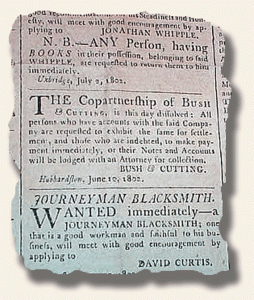How the Newspaper Changed the Press: Providing Contextual History…
September 2, 2010 by GuyHeilenman · Leave a Comment
Imagine the newspaper in pre-revolutionary Virginia. It’s the only one in the state, so the governor has complete control over everything that’s published in it. His is the only opinion expressed, and if anything about a newspaper page fails to agree with him, it’s discarded and replaced. Thomas Jefferson sums it up by saying that it’s “no competitor for public favor.” One of the most attractive elements of a newspaper for the public is its variety of opinions, which ensures that everyone can find something to agree and disagree with when they read it. What is a newspaper without multiple viewpoints, opinions, and descriptions of events?
Context is one important characteristic that distinguishes the pre-revolutionary newspaper from the modern one. Now, newspapers allow us to define context using not only the circumstances and facts surrounding an event, but also the wide variety of public opinions and perspectives. This additional facet of contextual history provides a wealth of detail, dimension, and complexity to the texture of events and situations covered in newspapers.
The Turning Point of the Newspaper
Roger Mellen of George Mason University has researched the origins of newspaper competition, working to contradict the assumption that Thomas Jefferson was responsible for bringing it to Virginia. Mellen contends that it was the Stamp Act, not Jefferson, which influenced a second newspaper printer to relocate in Virginia, instigating competition against the governor’s newspaper. Because printers had to pay extra taxes on their products, they were motivated to sell more newspapers by allowing for civic discourse, taking sides on issues, and becoming more opinionated. Printers realized that the “public favor” mentioned by Jefferson was best courted by publishing dramatic political writing, a phenomenon that grew and changed with the public both during and after the revolution. With the public steering the direction of newspapers, the government no longer had the sole influence on what was published, and the scope of contextual history was broadened significantly.
Collecting Context
The way newspapers capture contextual history is just one of many characteristics that influence collectors to continuously search out and buy them. Finding contrasting opinions on a significant political issue, reading different accounts of the same important situation, and even locating various photos depicting the same event can be exhilarating. Tracking the changes in leading public opinion across an extended time period, comparing historical events to modern ones, and finding historical patterns are also hobbies that are enabled by newspapers’ contextual history. No matter what their interests, everyone can learn something from and enjoy the process of collecting newspapers.
Bio: Alexis Bonari is a freelance writer and blog junkie. She is currently a resident blogger at First in Education, researching areas of online education. In her spare time, she enjoys square-foot gardening, swimming, and avoiding her laptop.



